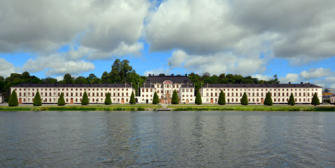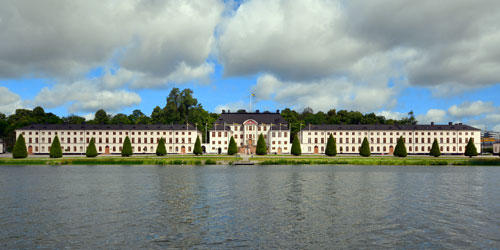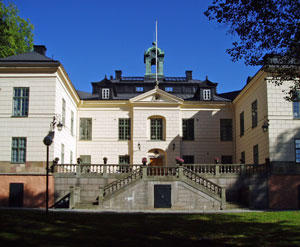

Copyright © Hans Högman 2021-01-11


History of the Royal
Karlberg War Academy,
Sweden
Karlberg War Academy
The Royal War Academy in Karlberg (Kungliga
Krigsakademin i Karlberg), Stockholm - Sweden, was
inaugurated in 1792 and is the oldest war academy
in the world still remaining at the same locality.
The academy is located at Karlberg Palace,
Stockholm.
The first generation of cadets began their education
in November 1792.
Both army and navy cadets were, at this time,
trained at the academy.
In the beginning cadets were accepted at Karlberg at
an age between 11 and 13 and the
training/education of the cadets were for 5 years.
In 1797 the period of training were reduced to 4
years and the age for admission to the training was
raised to 14. The education at the academy
contained training both in regular school subjects as
well as training in military ones.
To the right
is an image
of the
Karlberg War
Academy,
Stockholm,
Sweden.
Free image,
Wikipedia.
At this time there were no demand that the officers
had to pass an officer’s exam at the Karlberg War
Academy in order to get a commission. There were
also education/training for officers at the various
regiments.
The Karlberg cadets had to compete with cadets
trained at the regiments and an disadvantage for
the war academy cadets were the fact that they
were lacking experience of commanding troops. On
the other hand the war academy cadets had an
advantage in getting a position as a staff officers.
In 1835 it became compulsory for all officers to pass
an official exam in order to receive a commission as
officers. In 1867 it was ruled that the training and
examination of offices was to be held at the War
Academy in Karlberg.
In 1852 it became necessary to have a degree from
a high school (UK: grammar school) in order to be
appointed for training at Karlberg. This was a step in
changing the war academy into an academy primary
focusing on military subjects. The transformation
was completed in 1863 and the name of the
academy was changed to “Krigsskolan i Karlberg”.
In 1873 it was ruled that the cadets had to pass the
regimental and recruit training in order to be
admitted to Karlberg and from this point there was
no longer any education in regular school subjects.
From now on the training at Karlberg War Academy
entirely focused on military subjects.
Until 1867 both navy and army cadets were
educated at Karlberg. The Navy cadets then moved
to the new School of Naval Warfare.
In 1999 the education of Army and Navy were
unified again at Karlberg and since 2003
accompanied by air force officers. Today the War
Academy at Karlberg is called “Militärhögskolan i
Karlberg” (Military Academy Karlberg).
School of Naval Warfare
Between 1756 and 1792 there was a naval cadet
school at Karlskrona Naval Base. However, in 1792
the cadet school was moved to the Karlberg War
Academy in Stockholm. Until 1867 both navy and
army cadets were educated at Karlberg.
In 1867 the School of Naval Warfare
(Sjökrigsskolan) was founded. The training of naval
officer was then separated from the Karlberg War
Academy and transferred to the new School of Naval
Warfare.
Between 1879 and 1943 the School of Naval Warfare
was located at Skeppsholmen, Stockholm Naval
Base. Between 1943 and 1987 the Navy academy
was relocated to Näsby Palace, Täby, just north of
Stockholm.
From 1987 the School of Naval Warfare is back at
Karlberg. There is also a Naval Combat School
(Sjöstridsskola) at Karlskrona Naval Base. Further, a
naval collage was founded
in 1898.
To the left is an image of
the School of Naval Warfare
at Näsby Palace, Täby,
Stockholm, Sweden. Free
image, Wikipedia.
Karlberg Palace
The War Academy is located to the Karlberg Palace,
Stockholm. The palace is from the 1630’s and is
named after the founder, Baron Carl Carlsson
Gyllenhielm.
In 1669 the castle was acquired by Chancellor Count
Magnus Gabriel De la Gardie and the castle was now
redesigned received its present appearance. In 1684
the castle became a royal property through the so-
called Reduction and in 1792 it was handed over to
the War Academy.
During the regency of King Gustav IV, architect Carl
Christoffer Gjörwell was ordered to enlarge the
palace to accommodate the cadets, which in 1796
resulted in the elongated wings giving the palace
much of its character.
Various Names of the War Academy




















